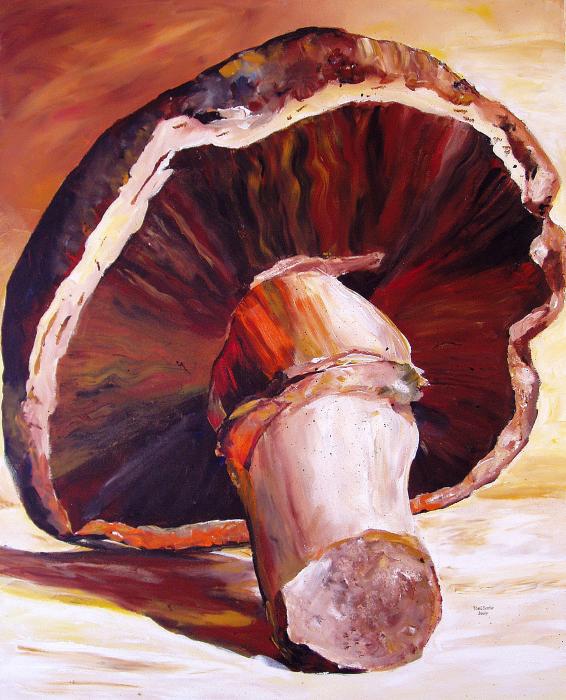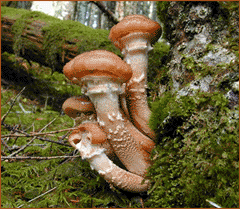Mushrooms...Glorious Mushrooms
By Louis S. Luzzo, Sr.
 Did you ever wonder how and why certain foods became known as edible? For instance, who was it that first decided they would try milking a cow after watching a newborn calf suckle, reaching under, squeezing out a bit of milk from an udder and then deciding to taste it? Now that's a 'Foodie!' We have many brave pioneers to thank for paving the way for the plethora of culinary excursions and delights we now enjoy.
Did you ever wonder how and why certain foods became known as edible? For instance, who was it that first decided they would try milking a cow after watching a newborn calf suckle, reaching under, squeezing out a bit of milk from an udder and then deciding to taste it? Now that's a 'Foodie!' We have many brave pioneers to thank for paving the way for the plethora of culinary excursions and delights we now enjoy.
Well, I've always wondered the same about mushrooms. After all, it is a fungus, usually found growing on or under tree roots. And, only certain ones are edible, with some psilocybic types, or 'Shrooms,' sending anyone who eats them on a psychadelic trip into mind  numbing halucinations. It has long been held that Alice's trip through the looking glass started with a mushroom. "Go ask Alice....when she's ten feet tall."
numbing halucinations. It has long been held that Alice's trip through the looking glass started with a mushroom. "Go ask Alice....when she's ten feet tall."
Yet others are so toxic and deadly, they can kill you with just one nibble. How did they find the edible ones? For instance, back in Egypt, who drew the short straw when, upon finding this little darling growing on a tree stump, they all looked at each other and said, "Who, me? No way! Pharoh schmaroh, I'm not putting that in my mouth!" Did they try them on 'subjects?' Was there a checklist, so that when Harry, the tester, dropped dead after eating this new variety brought in from the forest, we documented it? Talk about a position with no job security.
Whatever the reason for trying them, thank God someone had the courage to eat these little beauties, transforming them into the well loved staple of stews, soups, and the now many and diverse applications, from liqueurs to dusts, that we all enjoy today.
 What I found amazing in my research was that, most people think of a mushroom as the fungi, when it actuality it is the 'fruit' of the fungi. The mycelium , the main body, is subterranean, or lives on dead trees and living tree roots and it can vary in size from a few inches to several miles wide! When they absorb a large amount of water, they can grow amazingly fast and their fruits sprout out of the ground overnight. Have you ever woken up, gone to get the paper and gazed out at your front lawn after a good soaking rain only to be confronted with an invasion of mushrooms that have miraculously appeared overnight? Well, they were there all along! You can put that mystery to bed...I know it's been bugging you....Now you know.
What I found amazing in my research was that, most people think of a mushroom as the fungi, when it actuality it is the 'fruit' of the fungi. The mycelium , the main body, is subterranean, or lives on dead trees and living tree roots and it can vary in size from a few inches to several miles wide! When they absorb a large amount of water, they can grow amazingly fast and their fruits sprout out of the ground overnight. Have you ever woken up, gone to get the paper and gazed out at your front lawn after a good soaking rain only to be confronted with an invasion of mushrooms that have miraculously appeared overnight? Well, they were there all along! You can put that mystery to bed...I know it's been bugging you....Now you know.
These little fruits, mushrooms, are the delicasies that we humans enjoy. There are over two thousand types of mushrooms, but only 2 ½ - 5 % are edible. The rest are highly poisonous and can  masquerade as the edible ones, which is why if you are going to try your hand at foraging for wild mushrooms, make sure you do it with someone who is qualified in distinguishing the real deal from the pretenders. It's a risky and sometimes fatal business. Who would of thought of mushroom foraging as a "Deadliest Job?"
masquerade as the edible ones, which is why if you are going to try your hand at foraging for wild mushrooms, make sure you do it with someone who is qualified in distinguishing the real deal from the pretenders. It's a risky and sometimes fatal business. Who would of thought of mushroom foraging as a "Deadliest Job?"
Some 'shrooms' contain enough toxins to immediately kill the person who eats them, like the Amanitas strain. Historical records reveal that Claudius II and Pope Clement VII were both killed by enemies who poisoned them with this deadly variety. Buddha died, according to legend, from a mushroom that grew underground. Buddha was given the mushroom by a peasant who believed it to be a delicacy.
Mushroom Facts
- Mycophagy is the act of consuming mushrooms and dates to ancient times.
- Mushrooms have been an essential in Chinese medicine for centuries, containing vitamins B, C and D. They are known to lower both blood pressure and serum cholesterol.
- City of Hope, a cancer research facility, has suggested that mushrooms may help prevent cancer.
- The living body of the fungus is a mycelium made out of a web of tiny filaments called hyphae. The mycelium is usually hidden in the soil, in wood, or another food source.
- A mycelium may be small enough to fill a single ant or large enough to cover many acres.
- The branching hyphae can add over a half mile (1 kilometer) of total length to the mycelium each day!
- These webs live unseen until they develop mushrooms, puffballs, truffles, brackets, cups, “bird’s nests,” “corals” or other fruiting bodies.

- Mushrooms grow from spores, not seeds, and a single mature mushroom will drop as many as 16 billion spores!
- Some of the oldest living mushroom colonies are fairy rings ---> growing around the famous Stonehenge ruins in England. The rings are so large that the best view of them is from a plane.
Sources
www.chekyang.com, www.wikipedia.org, www.edupic.net,www.lifeinitaly.com, www.ehow.com, www.mushroom-appreciation.com, www.lemdell.com.au, www.groundtruthtrekking.org, www.foodists.ca, www/fineartamerica.com/featured/mushroom-still-life-toni-grote.html,





